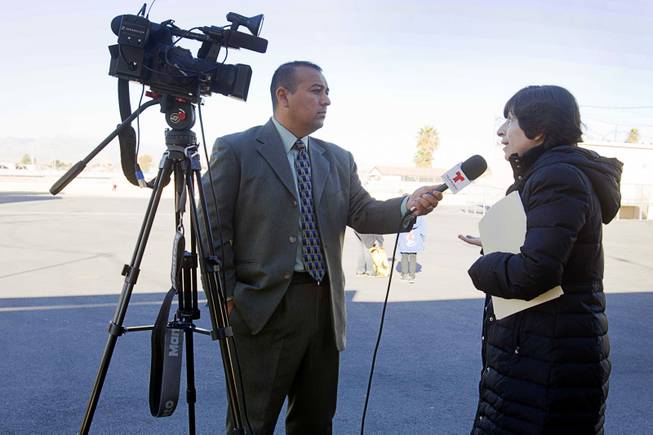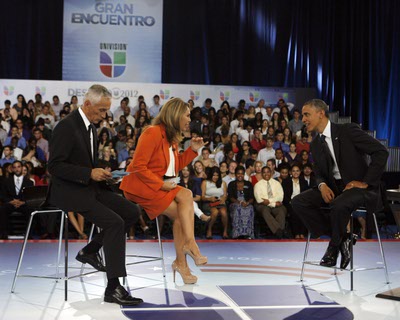
Telemundo journalist Abel Ortiz interviews a teacher during Education Awareness Day at Fay Herron Elementary School in North Las Vegas Feb. 25, 2013.
Monday, April 8, 2013 | 2 a.m.
In “El Capo 2,” one of the first original shows on new U.S. Spanish-language network MundoFox, a Colombian drug kingpin fights off challenges from all sides, the U.S. authorities, rival cartels in Mexico and the victims of his violence.
The show, from its origins and target audience to its plot, is emblematic of the escalating battle over Hispanic television viewers in the United States. In the world of U.S. Spanish-language television, Univision stands at the top with a majority of the audience while Telemundo nips at its heels. Other networks such as Azteca America and MundoFox are trying to carve out their own piece of the market, one that shows great potential for growth and increased interest from advertisers.
MundoFox launched in August and immediately sought to carve its own niche while challenging the traditional powers in the market, much like the Fox broadcast network did in 1986 when it went on air.
In a distinction from the popular telenovelas on market leader Univision, MundoFox airs “teleseries,” which have fewer episodes than telenovelas while emphasizing action and higher production value. “El Capo 2” was one of the first teleseries on MundoFox, which is a joint venture of Fox parent News Corp. and the Colombian broadcaster RCN Television. The first season aired in the United States on Univision’s sister network Telefutura. But under RCN’s partnership with News Corp., the popular and high-cost show moved to the upstart.
“There is an increasing demand for quality Spanish-language content in the U.S. from both viewers and advertisers,” Hernan Lopez, president and CEO of Fox International Channels, said at the announcement of MundoFox’s creation in January 2012. “Fox saw similar dynamics in play 25 years ago when it launched the Fox network, and it would be a missed opportunity not to provide an alternative for the 50-plus million Hispanic viewers who currently have limited options in Spanish-language broadcast television. Our partnership with RCN will help us do this, and we aim to do it in a big way.”
MundoFox launched in 49 markets, including Las Vegas, reaching an estimated 80 percent of U.S. Hispanic households, and has since added at least 10 more affiliates.
Not only are there more Spanish-language networks, the already-established networks are launching new channels to target specific audiences.
All of the action in television aimed at Hispanics comes with one target in mind: a piece of the $1 trillion in annual purchasing power of the U.S. Hispanic market.
Go where the growth is
Advertisers have awakened to the potential of reaching loyal viewers of Spanish-language television. In fact, ad dollars spent on Univision could pay off more than money spent on one of the major English-language U.S. networks.
Univision has been outperforming NBC in primetime viewing this season among adults 18-34. Univision is firmly entrenched as a top-five network in the United States in terms of viewers, and on some weeknights it beats more than one of the major English-language networks among adults 18-49.
While CBS, NBC and ABC all saw their total ad revenue fall from 2010 to 2011, according to Kantar Media, Univision saw an increase of 16.7 percent to about $2.18 billion, and Telemundo saw 2011 ad revenue rise 2.8 percent to about $915.4 million.
That kind of success among a relatively young and upwardly mobile demographic has caught the eyes of advertisers, networks and production companies.
The U.S. Hispanic population now stands near 50 million, and its members spend upward of $1 trillion a year, which would place the community among the top 20 economies in the world, according to a 2012 Nielsen report on Hispanic consumers. By 2015, Hispanic buying power is estimated to reach $1.5 trillion annually.
In Nevada, Hispanics account for a quarter of the population and make up half of all Clark County elementary school students. At $12 billion, the Southern Nevada market ranks 23rd in the nation for Hispanic purchasing power, according to market research firm Vision Advertising & Marketing.
Despite the down economy, U.S. Hispanic households that earn $50,000 or more annually are growing at a faster rate than total households, and the Hispanic population is expected to grow 162 percent by 2050. The total population is anticipated to grow only 42 percent. The median age of U.S. Hispanics, 27, also falls in the sweet spot of the 18-34 demographic for advertisers; the median age for non-Hispanic whites is 42.
Las Vegas’ Hispanic population does not compare to those in Los Angeles, New York or Chicago, but it is roughly a third of the population and is a fast-growing, diverse community. Las Vegas was included in MundoFox’s first list of coverage areas, and the city has affiliates for Azteca America, Telemundo and Univision.
Other Spanish-language stations available in the valley include V-me, EstrellaTV and Telefutura. The bigger networks also have sister channels such as Univision’s Galavision and UniMas, and NBC’s Mun2. National Geographic, ESPN, Discovery and Fox Sports all have Spanish-language cousins. More offerings from new and established networks are on the way. Comcast is funding a new network dubbed El Rey that will feature programming by director Robert Rodriguez.
“Las Vegas has been seen as a test market,” said Miguel Barrientos, an expert on Hispanic marketing and host of a radio program on KRLV 1340 AM. “It’s a smaller market. but it can be a good place to see how things are received, and there is room here for a lot of folks to get into the market.”
Univision pulls in big audiences for its news, variety shows and telenovelas, but competitors see an opening as the Hispanic population grows and evolves.
“The ‘New Latino’ audiences we are targeting are clearly more demanding than previous generations,” Emiliano Saccone, president of MundoFox, said in May 2012, when the network’s initial programming was announced.
“The mere fact that a program is in Spanish is not enough of a differentiator. Today’s Latino wants content that is more enriching, challenging and ‘Americano como tú’ (American like you),” he said, invoking the network’s tagline.
Besides the teleseries, which have English subtitles, MundoFox has a version of the game show “Minute to Win It” and also carries UFC fights and programming.
But Univision is not simply sticking with the hand it’s currently holding while Telemundo, MundoFox and others try to siphon off viewers.
Univision, which was founded in 1962 and for two decades was the only national Spanish-language network, has entered into distribution deals with Hulu and Microsoft Xbox. In October, Univision and ABC announced they were partnering on a new cable channel aimed at Hispanics. The English-language channel, called Fusion, is scheduled to launch late in 2013. Sandra Tomas Esquivel, Univision’s senior director for affiliate and local news, said Fusion would target the “bilingual population that leans more toward English than Spanish.”
“We are expanding our social media platforms at Univision media, and with Fusion we expect to grab the segment of our audience that leans toward English-language television,” Esquivel said. “They have strong ties to our culture and our heritage, and it’s going to be something attractive for them – especially for younger viewers that grew up in the United States.”
In one example of Spanish-language networks looking at their audience in new ways, Univision and NASCAR are co-producing a telenovela about a Hispanic female race car driver torn by her love for two other racers. The series airs online before making it onto the network.
More options for viewers and advertisers
Ray Garza, owner and head of Las Vegas’ Diversity Agency, said that 20 years ago it was hard convincing many businesses that advertising to Hispanics was worth the expense. Today, business owners are coming to him asking about how they can tap the market.
“I was in Los Angeles 20 years ago, and nobody was buying Spanish media spots," Garza said. “Now it’s more competitive than mainstream media. Spanish media costs more than mainstream in L.A. now. That will happen (in Las Vegas), as well.”
The increased competition means more content and options for viewers, and more points of entry for advertisers.
“The Hispanic market is ripe, low-hanging fruit,” Garza said. “The harvest is there. Businesses just have to be smart enough to allocate the commitment of money, staff and time to see results.
During the 2012 election season, Univision again flexed its muscle, scoring interviews with President Barack Obama and Republican challenger Mitt Romney. Spanish-language network news played a more prominent role than ever, which meant more campaign ad dollars. Garza and Barrientos said MundoFox would be wise to expand its news offerings.
“A local news show would be such as big plus for MundoFox,” Garza said. “If MundoFox jumps in to be a local news company and parallel what Fox did with its earlier time slots, I think they will get a lot of attention.”
Telemundo and Univision are the only Spanish-language stations in Las Vegas with a local news broadcast. However, MundoFox launched with a national news show and the affiliate in Las Vegas, KMCC, said it planned to have a local news team in place by June.
It’s a top priority for station manager Patrice Donely, who agreed local news would help increase KMCC’s presence and visibility in the community.
MundoFox and other smaller networks can be more accessible to smaller businesses and those that have not tackled the Hispanic market previously. Univision and Telemundo’s ad rates can be two or three times higher than Azteca America or MundoFox’s.
“At this point it’s all about cost,” Barrientos said. “The local businesses that can’t be on Univision because of the price scale can do MundoFox.”
KMCC had one ad sales agent before switching its affiliation to MundoFox last year but is now looking to hire three or four more, Donely said.
“There are definitely people out there now that don’t speak Spanish, but they want to tap the Hispanic market and we can be that bridge,” Donely said. “We help them walk over the bridge in a culturally appropriate way. Some sponsors just want to dub over their English-language ads, and that’s not always culturally appropriate.”
Before MundoFox, KMCC ran programming from the small network VasalloVision, which folded in 2012. Donely said it had been “looking for a MundoFox” to come along.
“It was just a great opportunity,” Donely said. “Fox, as a company, just doesn’t lose. When they first started, people said they couldn’t compete, but they grew and went out and got football and look at them now. We think they can do the same thing in the Hispanic market.”
While Univision fights to keep its place at the top, and MundoFox claws for market share as the newcomer with deep pockets, Telemundo, which is rolling out new, original content produced in the United States, may be the darkhorse for future success.
“I think NBC and Telemundo are poised for the future,” Barrientos said. “They are going into the younger Latino market and they are tapping into English dominant and bilingual Latinos. I think Mun2 programming, the reality shows, the bilingual and ‘Spanglish’ programs attract the younger market. That’s something we don’t see with Univision. They are sticking more to the Spanish-language programming and trying to control the market with that.”


Join the Discussion:
Check this out for a full explanation of our conversion to the LiveFyre commenting system and instructions on how to sign up for an account.
Full comments policy